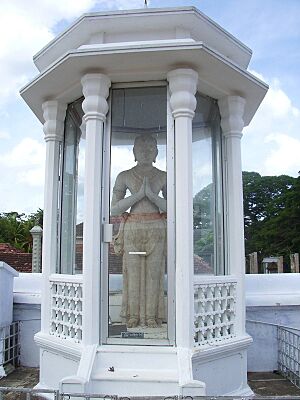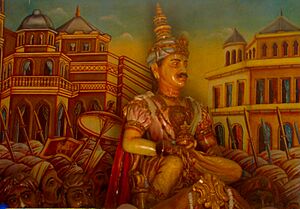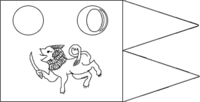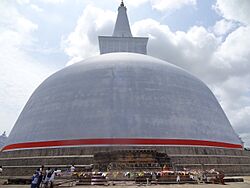Dutugamunu facts for kids
Quick facts for kids Dutugamunu the Greatගාමිණී අභය |
|||||
|---|---|---|---|---|---|
| King of Anuradhapura | |||||

Statue of King Dutugamunu beside Ruwanwelisaya Stupa
|
|||||
| Reign | 161 BC – 137 BC | ||||
| Coronation | 161 BC | ||||
| Predecessor | Elara | ||||
| Successor | Saddha Tissa | ||||
| Born | Thissamaharama, Hambanthota | ||||
| Died | 137 BC Anuradhapura |
||||
| Spouse | Queen Consort Ramani Bariya Kathi Queen Consort Rajitha Royal Concubine Kathika, ruler of Katiyawa division Royal Concubine Shardha(Krishna) A naagin |
||||
| Issue | Prince Saliya Princess Abhihitha Prince Ayesiva |
||||
|
|||||
| House | House of Vijaya | ||||
| Dynasty | House of Vijaya | ||||
| Father | Kavan Tissa | ||||
| Mother | Viharamahadevi | ||||
| Religion | Theravāda Buddhism | ||||
Dutugamunu the Great (Sinhala: දුටුගැමුනු), also known as Duṭṭhagāmaṇī Abhaya, was a powerful king of the Anuradhapura Kingdom. He ruled from 161 BC to 137 BC. He is famous for bringing the whole island of Sri Lanka together. He did this by defeating Elara, a Tamil ruler from the Chola Kingdom. Elara had taken over the Anuradhapura kingdom in 205 BC.
King Dutugamunu also made the city of Anuradhapura bigger and more beautiful. He helped the Rajarata kingdom become very strong across Sri Lanka. Many stories and legends are told about Dutugamunu. This is because he is a big symbol of Sinhalese power. But many parts of his life story have been proven by old writings. So, his main story is believed to be true.
Contents
What's in a Name?
Dutugamunu (Sinhala: දුටුගැමුනු) is also called Duṭṭhagāmaṇī Abhaya in the Pali language. The old book called the Mahavamsa tells us how he got his name. When he was young, he made fun of his father, King Kavantissa of Ruhuna. His father did not want to fight King Elara. Elara had ruled Sri Lanka for 45 years and was known as a fair king.
Young Gamani said his father was not brave for refusing to fight. He even sent his father women's jewelry. This made the king very angry. Many of Gamani's friends ran away. The prince himself was called Dutthagamani, which means "disobedient." After he died, people called him Dharma Gamini, meaning "righteous Gamini." But he is still best known as Dutugamunu.
His Family and Early Life
The Mahavamsa is the main source of information about Dutugamunu. It tells a lot about his story. He was from an old royal family in Rajarata. His father was King Kavantissa of Ruhuna. Ruhuna was a smaller kingdom in southern Sri Lanka. It was separate from Rajarata in the north. King Kavantissa was a very religious king. He strongly believed in Buddhism.
Dutugamunu's mother was Viharamahadevi. She was the daughter of King Tissa of Kalyani. A legend says that the sea flooded Kalyani because King Tissa had done something wrong. To stop the floods, Tissa put his daughter Devi in a golden boat. He wrote "A King's Daughter" on the side and sent her out to sea. Amazingly, she landed safely in Ruhuna. There, she married King Kavantissa.
When Viharamahadevi was pregnant with Dutugamunu, she had strange cravings. She wanted to sleep on a pillow made of honeycombs. She also wanted to drink water that had washed a sword. This sword had been used to defeat one of Elara's warriors. Court fortune-tellers said this meant her son would unite the kingdom. They said he would make Buddhism shine brightly. Viharamahadevi later gave birth to Gamani Abhaya. After him, she had another son named Tissa.
Around the time Gamani was born, a special elephant came. This elephant, named Kandula, became Gamani's loyal companion. He rode Kandula in many of his adventures. Dutugamunu also had a sister. Recent discoveries have found proof of her existence.
Early Challenges and Battles
By age sixteen, Gamani was strong and smart. He wanted to remove the ruler who had taken over Rajarata. Gamani gathered an army from Ruhuna. He told his father he planned to take back the north. But his father said, "The land on this side of the river is enough." This argument led to Gamani being called "Duttha Gamani." His friends ran away, and he was put in a royal prison.
King Kavantissa was a smart leader. He knew he needed to make his kingdom strong before fighting. He built up armies and made his kingdom rich. The famous "Ten Great Giants," who were very strong men, joined his army. Kavantissa made his sons, Dutugamunu and Tissa, promise never to fight each other. He also made them promise to always listen to the priests. The ten giants also promised not to pick sides if the brothers fought.
After Kavantissa died, Dutugamunu had to fight his younger brother Tissa. Tissa had taken the elephant Kandula and their mother, Viharamahadevi. The war between them began with Dutugamunu losing a battle. Many of his men died. Dutugamunu had to run back to Mahagama. He gathered another army and fought Tissa again.
Legend says Tissa rode Kandula, while Dutugamunu rode a mare. At one point, Dutugamunu made his mare jump over Kandula. The elephant recognized its true master and tried to throw Tissa off. Tissa quickly escaped. Dutugamunu won the battle. Tissa was secretly carried away, pretending to be a dead monk. Dutugamunu supposedly saw through the trick. He called out, "Are you not ashamed to be carried by these priests?" Later, Dutugamunu and Tissa made up. Their mother and the monks helped them. Tissa then became one of the king's top generals.
Uniting Sri Lanka
After becoming king, Dutugamunu planned to conquer the north. This area included Rajarata and other smaller kingdoms. His army had chariots, soldiers, and war elephants. Monks also joined to advise the king. A sacred relic was placed in his spear for good luck. He was also joined by the famous Ten Giant Warriors. His father, Kavantissa, had found these strong men from all over the island. Their names were Nandhimitra, Suranimala, Mahasona, Theraputtabhya, Gotaimbara, Bharana, Vasabha, Khanjadeva, Velusamanna, and Phussadeva.
Dutugamunu's campaign involved defeating many Tamil rulers in the north. The Mahavamsa says there were as many as 32. One important part was the four-month siege of Vijitanagara. The Tamil defenders reportedly used hot iron and melted tar to scare Dutugamunu's elephants. During this time, he also married Ran Etana. She was the daughter of a chief who still supported Elara. The king's cleverness and Kandhula's bravery helped win battles.
The campaign ended at the eastern gate of Anuradhapura. There, Dutugamunu, riding Kandhula, faced the old King Elara. Elara was on his own elephant, Mahäpabbata. Dutugamunu killed him with a spear. This fight is one of the most famous moments in Sri Lankan history.
Dutugamunu's victory meant he ruled almost all of Sri Lanka. Even though Elara was an invader, he was known as a fair leader. Dutugamunu made sure Elara was honored. He cremated Elara and built a tomb for his ashes. He even made rules for travelers to show respect at the tomb. Dutugamunu felt sad about the many lives lost in the war. He built many religious buildings to make up for it. These included grand stupas, monasteries, and shrines.
Building Projects and Later Life
King Dutugamunu started many huge building projects. Many of these still stand in Anuradhapura today. Each building has its own story.
One of his first buildings was the Maricavatti vihara, now called the Mirisavetiya. Legend says that Dutugamunu was at a water festival. He stuck his spear, which held a sacred relic, into the ground. When he tried to leave, no one could pull it out. He took this as a sign and ordered a stupa to be built over the spear.
Dutugamunu also ordered the building of the Lohapasada, or Brazen Palace. This was a nine-story house for monks. It got its name from its shiny copper-tiled roof. A legend says that monks saw the design for this palace in heaven. They drew it and sent it to the king.
Perhaps his most famous building was the Ruwanweliseya. It is also known as the Great Stupa or Swarnamalee Chetiya. It was built to hold the begging bowl of the Buddha. Construction began on a full moon day. This day is important for Buddhists. Elephants with leather-bound feet were used to pack down the stones. Dutugamunu watched the work closely. He was there when the Buddha's bowl was placed inside. Many people from different parts of India and even 30,000 monks from far away came for its dedication.
During his reign, Sri Lanka also had contact with traders from the west. These included Arabs, Persians, and possibly Romans.
King Dutugamunu also had a disagreement with his son, Saliya or Salirajakumara. Prince Saliya fell in love with a girl named Agokamaladevi. She was from a very low social group. Saliya refused to leave her and gave up his right to the throne. Folk stories say that the king eventually forgave the young couple.
His Death
King Dutugamunu did not live to see his beloved Ruwanweliseya finished. He died before the plaster work was done. The Mahavamsa describes his death. The dying king was carried to the unfinished stupa. He met his old friend Theraputtbhya, who was now a monk. After talking about life and death, the old king passed away. He was immediately reborn in a heavenly world.
A common folk tale says that as he was dying, people told him the Ruwanweliseya was finished. They wanted to make him happy. His brother Tissa covered the building with white cloth. This made it look like it was whitewashed. Because his eyesight was failing, Dutugamunu did not notice the difference. He died believing the building was complete.
After his death, Dutugamunu was followed by his brother Saddhatissa. His son Saliya did not become king.
See also
- Gemunu Watch
- Mahavamsa
- Ten Giant Warriors
- List of Sri Lankan monarchs
- History of Sri Lanka
Images for kids








